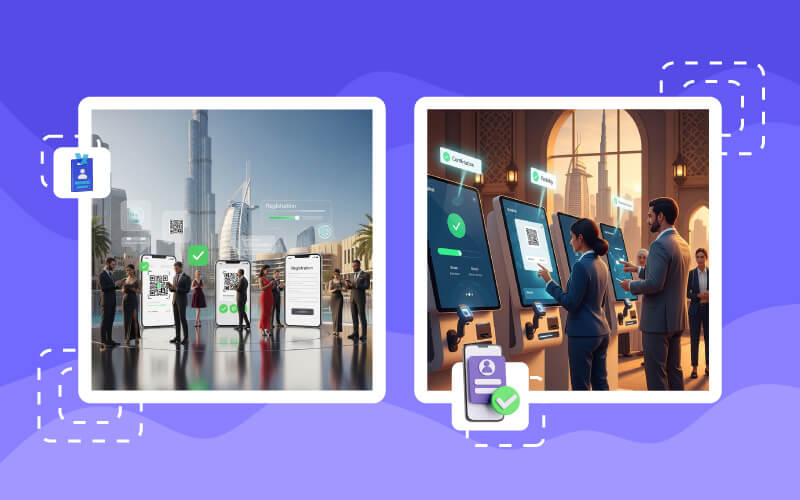Did you know that a staggering 80% of event organizers consider registration management the most critical aspect of their event planning? Whenever we plan an event, it’s clear that every detail and the participant’s first impressions matter. The key to getting those impressions is the seamless event registration process. However, your event’s success or failure depends on the effectiveness of the attendee registration procedure. Whether it’s event registration for meetings, conference management system, or workshops ;
Ready to optimize your event registration for workshops, conferences & more? Let’s uncover the strategies and expert tips for managing events that will elevate your event planning and leave a lasting impression on your attendees.
Optimize Event Registration for Conferences
Conferences are larger events designed to share knowledge on a wide range of topics with many speakers, sessions, and networking opportunities. For example, the Tech Innovators Conference might cover the latest in technology trends, featuring keynote speakers, panel discussions, and breakout sessions. However, this conference may include hundreds or even thousands of attendees(depending on type).
Select a Comprehensive Event Registration Platform
Choose a versatile event registration system like Dreamcast that can manage various registration ticket types (e.g., Standard, Premium, VIP), session selections, and personalization features like badges with QR codes. Ensure it is user-friendly and integrates well with other tools you use.
Build an Informative Conference Page
As you build your conference, the website or landing page becomes your front line. It should not just look appealing but function seamlessly. Keep it updated and accurate to foster trust among potential attendees. Present the conference event’s purpose, themes, key speakers, and sessions. Moreover, conference registration service providers should be straightforward—make sure all vital details like deadlines, fees, and policies are easy to find and understand.
Simplify the Conference Registration Process

Design straightforward conference registration and management services. Offer a clear, step-by-step approach for choosing event ticket types—such as early bird specials, standard rates, late registration, student discounts, and VIP packages—ensures you cater to a broad spectrum of attendee needs, selecting sessions, and signing up for additional activities. Ensure the conference registration process is mobile-friendly and user-friendly.
Read More: How to Choose the Right Event Ticketing Platform?
Promote the Conference Widely
Use diverse promotional strategies to reach potential attendees. Leverage email campaigns, social media, industry partnerships, and targeted advertising. Emphasize key aspects of the conference management system, such as prominent speakers and networking opportunities.
Provide Multiple Payment Options

When you select a conference registration service provider, check the payment capabilities. It should offer a range of payment methods to suit different preferences. Include options such as credit/debit cards, electronic payments, and invoicing for group registrations. However, offering a cashless payment system can be a great idea to boost attendees. Provide various pricing tiers, including early bird discounts and student rates.
Maintain Regular Attendee Communication
Keep in touch with attendees throughout the conference registration process. Send confirmation emails upon registration, provide updates on event details, and issue reminders about important deadlines. Use the conference registration service provider’s automated communication tools for efficiency.
Handle Cancellations and Refunds Efficiently
Clearly outline your cancellation and refund policy. Make sure this policy is communicated during event registration and provide an easy process for cancellations. Manage refunds promptly to ensure attendee satisfaction.
Leverage Event Check-in Technology and Tools
Implement advanced event check-in technologies to enhance the on-site experience. Utilize self-service kiosks, mobile event apps, turnstile access, facial recognition and QR code scanning to streamline the check-in process and reduce wait times. Ensure that staff are well-trained to assist with any issues that arise.
Gather Feedback and Catch Up
Finally, the end of the conference is just as crucial. Gather feedback from attendees to evaluate the success of the conference and identify areas for improvement. Use surveys and feedback forms to collect insights on various aspects of the event. These aspects include the registration process, sessions, and overall experience. Moreover maintain engagement after the conference by sharing post-event materials, such as recordings, presentation slides, or key takeaways.
Example Registration Form for Conference:
- Name
- Job Title
- Company/Organization
- Ticket Type (Standard, Premium, VIP)
- Conference Registration Type ( General Attendee, Speaker, Panelist, VIP, Exhibitor, Sponsor)
- Session Choices (e.g., Keynote, Workshop)
- Special Requests (e.g., dietary restrictions, accessibility needs)
Read More: Tips For Conference Event Management

How to Manage Meeting Registrations with Diverse Attendee Needs?
When managing event registration for meetings, clarity and simplicity are paramount. They often aim at internal discussions, decision-making, or smaller-scale strategic planning. For instance, a quarterly sales review meeting at a company involves key team members discussing performance metrics and strategies. Generally, a meeting includes 30-100 members, based on the size of the organization. Here’s how to manage meetings:
Choose a Simple Registration Platform For a Meeting
Begin by opting for a user-friendly event registration platform that streamlines the process. This platform should allow you to collect essential details, manage invitations, and handle different registration options if needed. Ensure the meeting registration service provider supports simple processes like click-through or reply registrations.
Design a Detailed Meeting Invitation
Craft a comprehensive invitation that clearly defines the meeting’s purpose—be it a strategy session, project update, product launch, or collaborative planning. Include a clear registration link or instructions, ideally embedded in calendar invites for convenience. Highlight key details such as the agenda, meeting thematic ideas, and key participants. In addition to this, ensure the meetings’ official website provides accurate and comprehensive registration details.
Streamline the Event Registration Process for Meetings
Ensure simplified event registration for meetings by using a straightforward meeting registration service provider. Ensure all registrants can easily complete their registration with a simple click-through or reply. For meetings with various needs, offer different event registration options (mobile app-based registration, onsite event check-in)based on roles or interests, and allow registrants to specify topics they wish to discuss.
Promote the Meeting
Effectively promote the meeting to ensure broad participation. Leverage the power of email campaigns, internal communications, and professional networks to spread the word. Emphasize the value and relevance of the meeting to attract the right stakeholders.
Offer Clear Communication between Hosts and Attendees
Communicate all relevant details. If there are registration fees, provide transparent payment instructions in the invitation. After event registration for meetings, send a confirmation email with meeting details, agenda, and any preparatory materials required.
Manage Cancellations
Do include cancellation terms and conditions. Make sure that the meeting registration service provider also includes a clear process for managing cancellations. Consider adding clear instructions on how to cancel and any associated deadlines or fees. Besides, ensure participants know how to contact you if they need to withdraw or reschedule.
Utilize On-site Tools
For in-person meetings, ensure that the meeting registration service provider has all the on-site registration tools ready, such as check-in registration desks or self-check-in kiosks, turnstile, onsite badge printing etc. This will help manage attendees efficiently and facilitate a smooth event registration for meetings and the entire check-in process.
Follow Up
After the meeting, send a follow-up email to participants. Include a summary of key points, distribute action items, and address any outstanding issues. This ensures continuity and reinforces the meeting’s outcomes.
Here’s an Example Registration Form for Meeting:
- Full Name
- Job Title
- Organization/Company
- Email Address
- Phone Number
- Meeting Date
- Time of Meeting
- Meeting Location
- Registration Type (General Attendee, Speaker, Panelist, VIP)
- Special requirements:
- Role in Meeting (Dropdown Menu: Attendee, Presenter, Moderator)
- Topics Interest
- Special Requests
- Payment Information
- How Did You Hear About This Meeting? (Email, Social Media, Colleague, Website)
- Consent and Agreement
How To Manage Event Registration For Workshops?
Workshops are interactive sessions focused on skill-building or deep dives into specific topics. Let’s delve into optimizing event registration for workshops:

1. Define Clear Workshop Objectives
Begin by setting clear goals for the workshop, such as skill enhancement or in-depth training. This focus will guide the entire registration management for the workshop, ensuring that you attract participants who are genuinely interested and align with the workshop’s purpose.
2. Maintain an Updated and Informative Website
Your workshop’s website should be a dynamic resource—regularly updated with detailed registration information, deadlines, and fees. An informative website builds trust and ensures that potential attendees have all the necessary details at their fingertips.
3. Offer Diverse Registration Options
Provide registration management for workshops with choices like early bird discounts, regular rates, and session-specific tickets. This approach not only accommodates different audience needs but also maximizes participation by catering to a broad spectrum of preferences and budgets.
4. Create a User-Friendly Registration Form
Design a simple and intuitive event registration form for workshops that collects all essential details without overwhelming the user. Ensure that the form is easy to navigate, clearly states any prerequisites, and allows for special requests if needed.
5. Streamline Check-In Processes
On the day of the workshop, simplify the registration management for the workshop including the entire check-in process with clear instructions and efficient systems. Consider using digital check-ins or self-service kiosks to reduce wait times and ensure a smooth start to the workshop.
6. Collect Feedback and Provide Additional Resources
After the workshop, gather feedback to assess its effectiveness and areas for improvement. Additionally, offer certificates of completion and share supplementary materials to reinforce the learning experience and keep participants engaged.
Here’s an Example of the Workshop Registration Form:
- Name
- Company/Organization
- Current Skill Level (e.g., Beginner, Intermediate, Advanced)
- Specific Goals for the Workshop
- Dietary Restrictions (if applicable)
- Materials Fee Payment (if applicable)
- Pre-Workshop Preparation (e.g., questionnaire, documents to bring)
Conclusion
By the end of this comprehensive blog, implementing these strategies and leveraging event registration platforms and conference management systems, organizers can streamline the entire registration process. However, it will not only enhance the attendee experience but also result in a successful event. Make sure that conference registration services and workshop registration management align with the initial event planning of conferences, meetings, and post-event follow-up.







